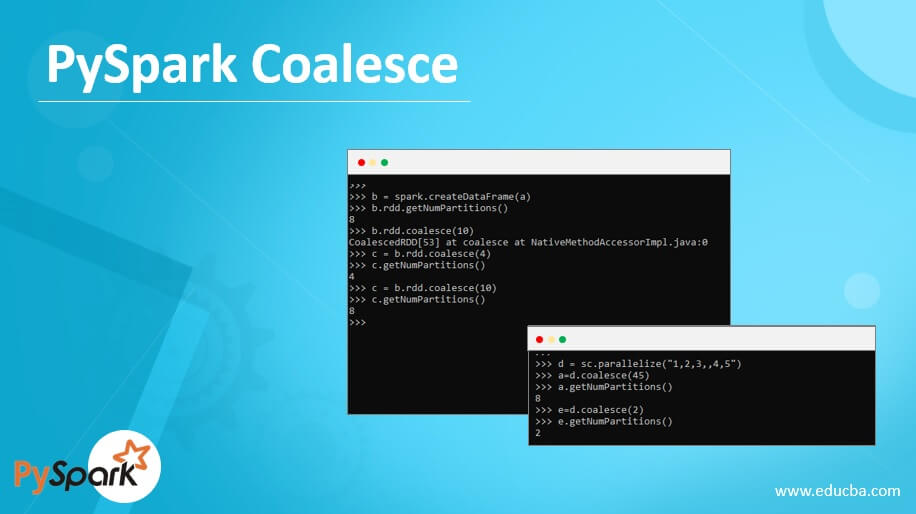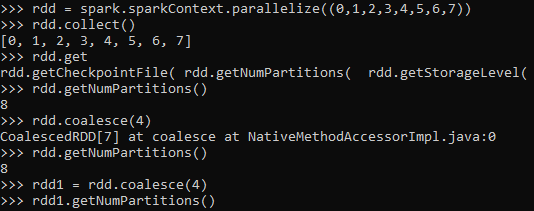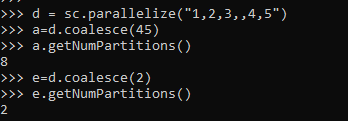Updated April 18, 2023

Introduction to PySpark Coalesce
PySpark Coalesce is a function in PySpark that is used to work with the partition data in a PySpark Data Frame. The Coalesce method is used to decrease the number of partitions in a Data Frame; The coalesce function avoids the full shuffling of data. It adjusts the existing partition resulting in a decrease in the partition. The method reduces the partition number of a data frame.
This is a much more optimized version where the movement of data is on the lower side. This comparatively makes it faster in the PySpark Data Frame model. This article will try to analyze the coalesce function in detail with examples and try to understand how it works with PySpark Data Frame.
Syntax:
The syntax for the PySpark Coalesce function is:
b = a.coalesce(5)- a: The PySpark RDD.
- coalesce: The Coalesce function works on a partition.
Screenshot:
How Coalesce in PySpark works?
Let us see how the COALESCE function works in PySpark: The Coalesce function reduces the number of partitions in the PySpark Data Frame. By reducing, it avoids the full shuffle of data and shuffles the data using the hash partitioner; this is the default shuffling mechanism used for shuffling the data. It avoids the full shuffle where the executors can keep data safely on the minimum partitions. This only moves the data off from the extra node. This uses the existing partitions that minimize the data shuffle. The amount of data in each partition can be evenly different. Coalesce using the existing transaction that makes it faster for data shuffling. The Coalesce creates a new RDD every time, keeping track of previous shuffling over the older RDD. Coalesce works with data with lots of partitions where it combines it down and produces a new RDD with lesser partitions avoiding the data shuffling and minimum movement over the network.
Example of PySpark COALESCE
Let us see some examples of PySpark COALESCE:
Example #1
Let’s start by creating a simple RDD over we want to understand the COALESCE Operation.
Creation of RDD:
rdd = spark.sparkContext.parallelize((0,1,2,3,4,5,6,7))
rdd.collect()
[0, 1, 2, 3, 4, 5, 6, 7]Screenshot:
Let’s check the partition that has been created while creating RDD. This can be done using the getNumpartitions(), this checks for the number of partitions that have been used for creating the RDD.
rdd.getNumPartitions()Screenshot:
We will start by using the coalesce function over the given RDD.
rdd1 = rdd.coalesce(4)CoalescedRDD[7] at coalesce at NativeMethodAccessorImpl.java:0
This RDD is partitioned and decreased to 4.
rdd1.getNumPartitions()The result shows the partition to be decreased by the amount of parameter given.
Screenshot:
Example #2
Let’s try to understand more precisely by creating a data Frame and using the coalesce function on it.
data1 = [{'Name':'Jhon','ID':2,'Add':'USA'},{'Name':'Joe','ID':3,'Add':'USA'},{'Name':'Tina','ID':2,'Add':'IND'}]A sample data is created with Name, ID, and ADD as the field.
a = sc.parallelize(data1)RDD is created using sc.parallelize.
b = spark.createDataFrame(a)
b.show()Created DataFrame using Spark.createDataFrame.
Screenshot:
The Data frame coalesce can be used in the same way by using the.RDD converts it to RDD and gets the NUM Partitions.
b.rdd.getNumPartitions()
c = b.rdd.coalesce(4)
c.getNumPartitions()ScreenShot:
Let us check some more examples for Coalesce function.
Example #3
Let us try to increase the partition using the coalesce function; we will try to increase the partition from the default partition.
b = spark.createDataFrame(a)
b.rdd.getNumPartitions()Here the Default NUM partition is 8. Let’s try to increase the partition with the coalesce function.
c = b.rdd.coalesce(10)
c.getNumPartitions()Here we can see that by trying to increase the partition, the default remains the same. So coalesce can only be used to reduce the number of the partition.
Screenshot:
Let us check some more examples of PySpark Coalesce:
d = sc.parallelize("1,2,3,,4,5")
a=d.coalesce(45)
a.getNumPartitions()
e=d.coalesce(2)
e.getNumPartitions()Screenshot :
These are the Examples of Coalesce functions in PySpark.
Note:
1. Coalesce Function works on the existing partition and avoids full shuffle.
2. It is optimized and memory efficient.
3. It is only used to reduce the number of the partition.
4. The data is not evenly distributed in Coalesce.
5. The existing partition is shuffled in Coalesce.
Conclusion
From the above article, we saw the use of Coalesce Operation in PySpark. We tried to understand how the COALESCE method works in PySpark and what is used at the programming level from various examples and classifications. We also saw the internal working and the advantages of having Coalesce in Spark Data Frame and its usage for various programming purposes. Also, the syntax and examples helped us to understand much precisely over the function.
Recommended Articles
This is a guide to PySpark Coalesce. Here we discuss the Introduction, syntax, and working of Coalesce in PySpark along with multiple examples. You may also have a look at the following articles to learn more –







